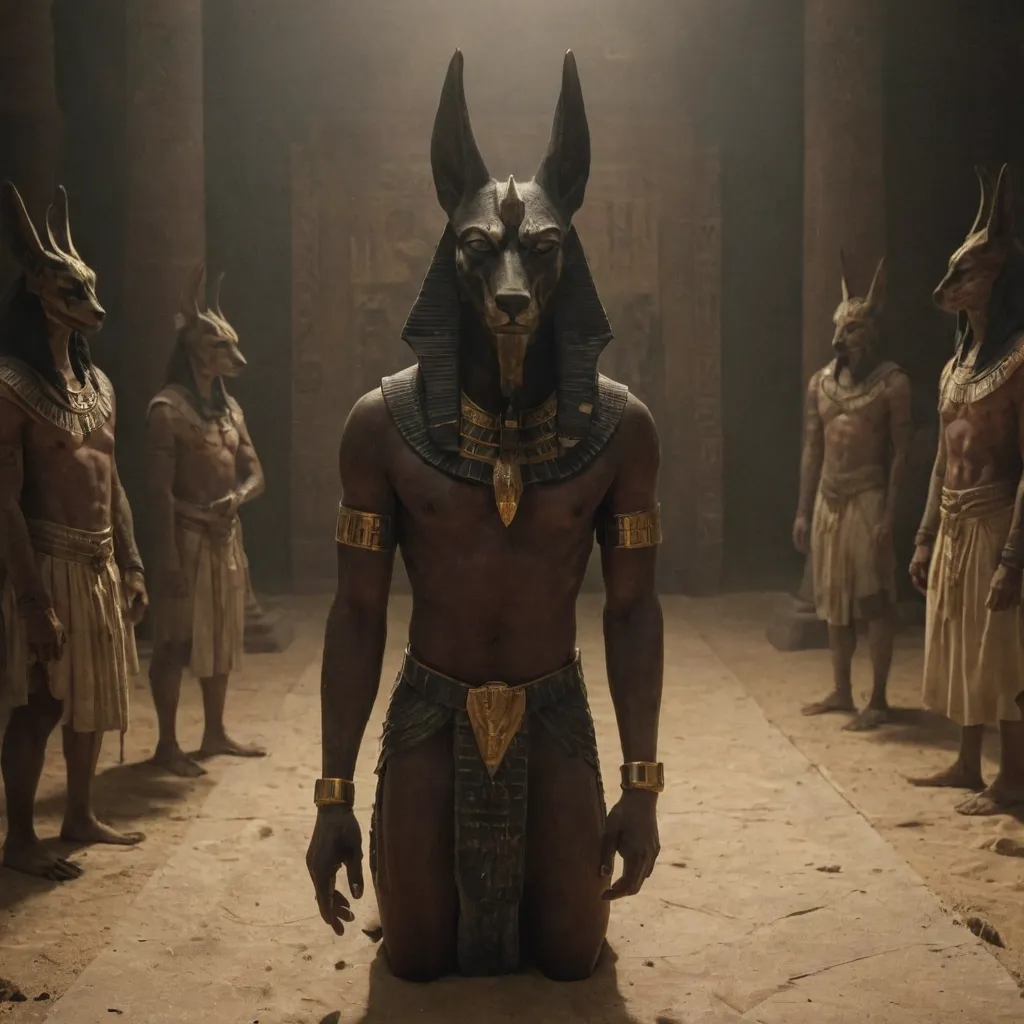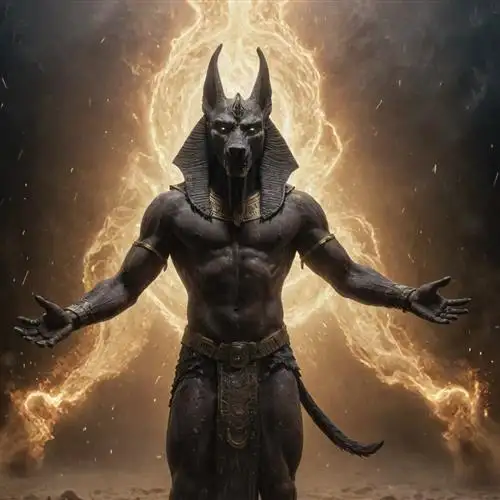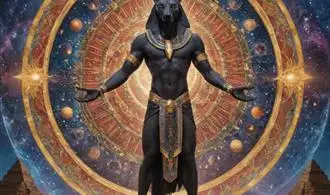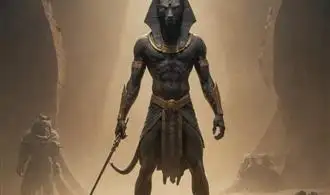
The Origins of Anubis Rituals
Anubis, the ancient Egyptian god of the dead, has been the subject of fascination and reverence for millennia. His rituals, steeped in the rich tapestry of Egyptian mythology, have captivated scholars and practitioners alike. To understand the origins of Anubis rituals, we must delve into the cultural and historical context that gave rise to this powerful deity.
The worship of Anubis can be traced back to the earliest dynasties of ancient Egypt, with evidence of his prominence in funerary rites and the afterlife. As the god associated with embalming, mummification, and the protection of the dead, Anubis played a crucial role in the Egyptian conception of the journey to the afterlife. His rituals were, therefore, intrinsically linked to the process of preparing the deceased for their final passage.
One of the most significant Anubis rituals was the Opening of the Mouth ceremony, a complex and symbolic process that aimed to restore the deceased's ability to speak, breathe, and interact with the divine. This ritual was performed by priests, who would use specialized tools and incantations to "open the mouth" of the mummy, allowing the soul to commune with the gods and take its rightful place in the afterlife.
Another important Anubis ritual was the Weighing of the Heart, a crucial step in the judgment of the dead. During this ceremony, the heart of the deceased was weighed against the feather of truth, symbolizing the individual's moral and ethical conduct throughout their life. The presence of Anubis, as the overseer of this process, lent the ritual a sense of gravity and importance, underscoring the gravity of the decision that would determine the fate of the soul.
Beyond the funerary rituals, Anubis was also revered in various healing and protective rites. His association with the embalming process and his role as a guide to the afterlife made him a powerful figure in the Egyptian pantheon, and his rituals were often invoked to seek his favor and protection.
Essential Anubis Ritual Supplies
Conducting Anubis rituals requires a carefully curated set of supplies to ensure the efficacy and authenticity of your practices. As the Egyptian god of the dead, embalming, and the afterlife, Anubis demands reverence and precision in his rituals. Let's explore the essential items you'll need to create a sacred space and invoke the presence of this powerful deity.
Altar and Altar Cloth: The foundation of your Anubis ritual is the altar. Choose a sturdy surface, such as a wooden table or a dedicated altar, and cover it with a black or deep blue altar cloth. This color scheme aligns with Anubis's association with the underworld and death.
Candles: Candles are a crucial element in Anubis rituals, symbolizing the light that guides the dead through the afterlife. Use black, white, or a combination of both candles to create an atmospheric and reverent setting.
Incense: The scent of incense is believed to attract and please Anubis. Consider using resins like frankincense, myrrh, or sandalwood, as they are associated with ancient Egyptian rituals and the divine.
Anubis Figurine or Statue: Having an Anubis figurine or statue on your altar serves as a focal point for your ritual and helps to invoke the deity's presence. Look for representations that capture Anubis's jackal-headed form or his distinctive black coloration.
Ritual Tools: Depending on the specific ritual, you may need additional tools like a chalice, athame (ritual knife), wand, or bowl for offerings. These items should be consecrated and used solely for Anubis-related practices.
Offerings: Anubis appreciates offerings that relate to his realm of influence. Common offerings include fresh flowers, especially white lilies or lotus blossoms, food and drink, and small items like amulets or jewelry.
Ritual Clothing: While not strictly necessary, wearing ritual robes, cloaks, or other garments that evoke the ancient Egyptian aesthetic can enhance the atmosphere and your connection to the ritual.
Sacred Texts or Scrolls: Having access to ancient Egyptian texts, hymns, or spells related to Anubis can deepen your understanding and add authenticity to your rituals.
Preparing for an Anubis Ritual
Engaging in Anubis rituals requires meticulous preparation to ensure a profound and transformative experience. Begin by creating a sacred space that resonates with the energy of Anubis, the Egyptian god of the dead. This can be accomplished by cleansing the area with incense, salt, or other purifying elements, and arranging it with items that hold symbolic significance, such as candles, statues, or representations of Anubis.
It is crucial to approach the ritual with a clear and focused mind. Take time to meditate, engage in breathwork, or perform other practices that help you center and ground yourself. This preparatory work allows you to tap into the deeper layers of consciousness and connect more authentically with the energy of Anubis.
Before the ritual, it is beneficial to research the specific purpose or intention you wish to explore. Anubis is associated with a vast array of themes, including death, the afterlife, transformation, and the protection of the soul. Aligning your ritual with a specific goal or area of focus can help you direct your energy and attention more effectively.
Another important aspect of preparation is the selection and consecration of ritual tools and objects. This may include items such as a ceremonial robe, a statue or image of Anubis, or various sacred implements used in the ritual. Cleanse and imbue these items with the appropriate energies through rituals, prayers, or meditations.
It is also crucial to consider the timing of the ritual. Certain astrological alignments or lunar phases may be more favorable for Anubis-related work. Consult astrological calendars or work with experienced practitioners to determine the most auspicious time to conduct your ritual.
Invoking the Presence of Anubis
Invoking the Presence of Anubis is a sacred and ancient ritual that requires deep reverence and careful preparation. Anubis, the Egyptian god of the dead, is a powerful and enigmatic figure who holds dominion over the transition from life to the afterlife. Summoning his presence is not to be taken lightly, as it demands a profound understanding of the rites and a steadfast commitment to the process.
At the heart of the Anubis ritual lies the need for purification, both of the physical body and the spiritual self. Practitioners must engage in a thorough cleansing, often through the use of ritual baths, sage smudging, or other forms of energetic clearing. This process is essential in creating a sacred space and aligning the individual with the vibration of the divine.
The ritual itself begins with the invocation of Anubis, typically through the recitation of powerful mantras or the chanting of his sacred name. As the practitioner calls upon the god, they must maintain a deep state of focus and reverence, allowing their energy to resonate with the essence of Anubis. Visualization techniques, such as picturing the jackal-headed deity or imagining his presence in the space, can aid in this process.
Offerings to Anubis are a crucial component of the ritual. Traditional offerings may include black candles, myrrh, obsidian, or other items associated with the underworld and the cycle of death and rebirth. These offerings serve as a way to honor the god and establish a connection with his realm.
Throughout the ritual, the practitioner must remain centered and attuned to the energy of Anubis. Meditation, deep breathing exercises, and the use of sacred symbols or talismans can help deepen the connection and heighten the experience. It is important to approach the ritual with a sense of humility and an understanding that the presence of Anubis is not to be taken lightly.
Upon the successful invocation of Anubis, the practitioner may experience a range of phenomena, from visions and intuitive insights to physical sensations or a profound sense of transformation. The experience is highly personal and can vary depending on the individual's spiritual alignment and the depth of their connection with the god.
Meaningful Offerings to Anubis
When honoring the Egyptian god Anubis, the jackal-headed deity associated with the afterlife, mummification, and the protection of the dead, the choice of offerings holds great significance. These offerings are not merely tokens but serve as a means of communication and reverence between the devotee and the divine. By understanding the symbolic meaning and traditional practices surrounding Anubis' preferred offerings, one can deepen their connection and demonstrate their respect for this powerful ancient deity.
One of the most revered offerings to Anubis is the black dog or jackal, animals sacred to the god and often used in his iconography. These creatures were believed to possess a close affinity with the underworld and the realm of the dead, making them fitting tributes to the lord of the necropolis. In ancient times, the black dog or jackal would be mummified and placed within the tomb or temple as an offering to Anubis, symbolizing the devotee's desire to ensure the deceased's safe passage to the afterlife.
Another important offering is natron, a natural salt compound that played a vital role in the mummification process. As the god responsible for overseeing the embalming of the dead, Anubis was closely associated with natron, which was used to desiccate the body and preserve it for eternity. Presenting natron as an offering demonstrated the devotee's understanding of the importance of this substance in the rituals and rites overseen by Anubis.
Myrrh, a fragrant resin derived from certain tree species, was also a significant offering to Anubis. This aromatic substance was used in various funerary rites and was believed to have purifying and protective properties. Burning myrrh as an offering to Anubis was thought to create a sacred atmosphere, honoring the god's role as the guardian of the dead and the embalming process.
Additionally, the ibis bird, a symbol of the god Thoth, was sometimes offered to Anubis, as Thoth was considered a close associate of the jackal-headed deity. The ibis was believed to possess divine knowledge and was associated with the afterlife, making it a fitting tribute to the lord of the necropolis.
Closing the Anubis Ritual
Closing the Anubis Ritual is a critical step that ensures the ritual's energy is properly contained and the connection with Anubis is respectfully severed. This process involves specific actions and considerations to ensure a safe and effective conclusion to your spiritual work. Here are the key elements to focus on when closing an Anubis ritual:
Gratitude and Acknowledgment: Begin by expressing your sincere gratitude to Anubis for their presence and guidance during the ritual. Acknowledge the power and wisdom the deity has shared with you, and thank them for their benevolence. This gesture of respect helps to maintain a positive relationship with Anubis and demonstrates your understanding of the sacred nature of the work.
Energy Clearing: Once you have expressed your gratitude, it's important to clear the ritual space of any lingering energy or residue. This can be done through smudging with sage, visualization techniques, or the use of other cleansing tools like crystals or sound. Ensure that the space feels refreshed and balanced, ready to return to its normal state.
Sealing the Ritual: To formally close the ritual, perform a specific action or series of actions that signify the ending of your connection with Anubis. This could involve extinguishing candles, closing a sacred circle, or reciting a closing prayer or affirmation. The goal is to create a clear energetic boundary between the ritual space and the mundane world, signaling the conclusion of your work.
Grounding and Centering: After the ritual is closed, take time to ground and center yourself. This helps to integrate the energy and insights you've received, and to return your focus to the present moment. Consider practicing deep breathing, meditation, or a simple walking meditation to help you transition back to your everyday life.

















